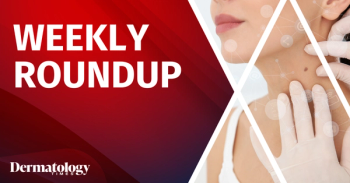
Top 5 Articles of the Week: April 27-May 2
Key Takeaways
- GLPSGLT serum improves facial skin quality in patients using GLP-1 RAs, addressing issues like thinning and elasticity within 6 weeks.
- COVID-19 pandemic increased risks for DIMIDs patients, with vaccination and healthy lifestyle factors providing some protection.
Explore the top headlines of the week including insights on the latest clinical trials, therapeutic updates, and more.
To stay up-to-date with the latest dermatology news, sign up to receive our
1. Novel Serum Improves Facial Skin Quality in Patients Using GLP-1 Receptor Agonists
A novel skin care treatment has been developed for patients with reduced facial skin quality due to the use of Glucagon-like peptide-1 receptor agonists (GLP-1 RAs) and SGLT-2 inhibitors. The topical serum, GLPSGLT, showed improvements in thinning, elasticity, and other factors of accelerated skin aging after just 6 weeks of treatment. More and more patients are turning to accessible GLP-1 RAs for the treatment of type 2 diabetes, obesity, and cardiovascular disease, with the amount likely to increase.
2. Patients with DIMIDs and Pandemic Risks
The COVID-19 pandemic significantly affected patients with immune-mediated inflammatory diseases (DIMIDs), including atopic dermatitis (AD), psoriasis, and vitiligo. The fear of morbidity, mortality, and vaccine hesitancy contributed to disruptions in their daily lives. Patients with immunodeficiency diseases, older individuals, males, and those of non-White ethnicity were at an increased risk of severe COVID-19 outcomes. Interestingly, vaccination, a healthy diet, and atopic conditions were considered protective factors against COVID-19. A recent prospective observational, multicenter, multidisciplinary cohort substudy explored the impact of COVID-19 disease and vaccination on DIMIDs, specifically AD, psoriasis, and vitiligo.
3. FDA Approves First Gene Therapy for RDEB
The US Food and Drug Administration (FDA) officially approved prademagenezamikeracel (pz-cel) (Zevaskyn; Abeona Therapeutics), marking a significant advancement for individuals living with recessive dystrophic epidermolysis bullosa (RDEB). Developed by Abeona Therapeutics, pz-cel is the first autologous, cell-based gene therapy specifically designed to address the genetic cause of RDEB, offering a new therapeutic option for a disease with historically limited treatment choices.
“The past 2 years have transformed EB management, with 3 distinct FDA approvals reflecting different topical strategies—topical gene delivery, botanical pharmacologic therapy, and now autologous cell sheet-based gene therapy," said Dermatology Times Editor and Chief Christopher Bunick, MD, PhD. "Pz-cel, the first FDA-approved autologous cell sheet-based gene therapy for RDEB, expands our therapeutic toolkit, allowing dermatologists to better tailor care to EB subtype and individual patient needs.”
4. The Unprecedented Phase 1 Results of ET-02 for the Treatment of Androgenic Alopecia
Eirion Therapeutics has reported promising first-in-human trial results for ET-02, a topical treatment for androgenic alopecia. The drug showed exceptional safety with no local or systemic adverse effects and delivered unprecedented hair regrowth in just 5 weeks—6 times more than placebo and even outperforming minoxidil’s four-month results. Unlike current treatments that stimulate the hair follicle or stem cell, ET-02 targets a correction in defective stem cell biology to restore normal hair growth. With this novel mechanism, ET-02 could reshape the hair loss treatment landscape and potentially play a role in future prevention strategies.
5. Upadacitinib Outpaces Dupilumab in Rapid AD Symptom Control
The phase 3b/4 LEVEL UP study, presented at the 2025 American Academy of Dermatology (AAD) meeting, investigates the comparative efficacy of 2 approved systemic treatments: upadacitinib (UPA), a selective Janus kinase (JAK) inhibitor, and dupilumab (DUPI), an interleukin-4 and -13 receptor antagonist. This head-to-head, randomized, open-label, assessor-blinded trial enrolled adolescents and adults aged 12 to under 64 with moderate to severe AD who had an inadequate response to systemic therapy or for whom such therapy was inadvisable.
“Within days following treatment initiation, a higher proportion of patients receiving UPA achieved clinically meaningful itch improvement and minimal-to-no itch than patients receiving DUPI,” researchers behind the study wrote.
Newsletter
Like what you’re reading? Subscribe to Dermatology Times for weekly updates on therapies, innovations, and real-world practice tips.


















